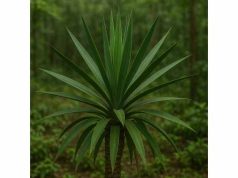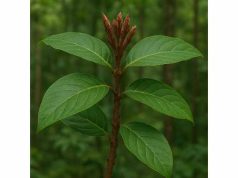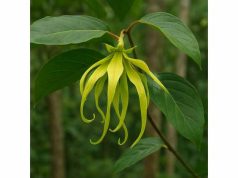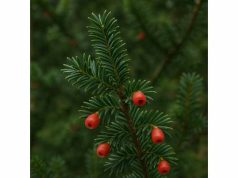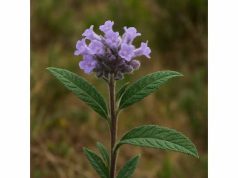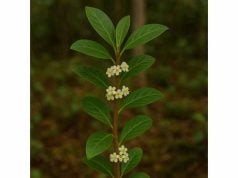
Yautia, scientifically named Xanthosoma sagittifolium, is a nutrient-dense tropical tuber celebrated across continents for its creamy texture and versatile, diverse nutritional applications. Packed with complex carbohydrates, dietary fiber, vitamins C and B6, and minerals such as potassium and magnesium, this root vegetable promotes balanced energy release, digestive harmony, and cardiovascular wellness. Its rich array of phenolic acids, flavonoids, and tannins deliver potent antioxidant and anti-inflammatory support, making yautia valuable in traditional remedies for issues spanning blood sugar regulation to wound care. From savory stews and purees to soothing teas and poultices, yautia’s blend of active compounds and mild flavor enriches both culinary and medicinal traditions.
Table of Contents
- Botanical Characterization and Habitat
- Chemical Makeup and Principal Constituents
- Wellness Advantages and Core Qualities
- Culinary Applications and Precautionary Guidance
- Research Highlights and Noteworthy Findings
- FAQ
Botanical Characterization and Habitat
Yautia belongs to the Araceae family, a diverse group of monocotyledonous flowering plants that includes familiar species like taro (Colocasia esculenta) and philodendrons. Within this lineage, it is classified as:
- Kingdom: Plantae
- Division: Angiosperms
- Class: Monocots
- Order: Alismatales
- Family: Araceae
- Genus: Xanthosoma
- Species: X. sagittifolium
Morphological Features
Yautia plants grow from underground corms—rounded, knotty stems that serve as storage organs. From each corm sprout one to several pseudostems composed of overlapping leaf sheaths. The leaves themselves display an elegant sagittate (arrowhead) shape, measuring 30–60 cm long, with smooth margins and a lustrous green surface. Leaf veins radiate prominently from the central midrib, channeling water efficiently. Flower structures—rarely seen in cultivation—develop on a spadix enclosed by a greenish-white spathe that later gives way to bright orange berries.
Varietal Diversity
Over centuries, farmers have selected for traits such as tuber size, flesh color (white, yellow, pink, purple), and reduced cormimosis (lignification around the periderm). Purple-fleshed cultivars often contain higher anthocyanin levels, resulting in both striking appearance and enhanced antioxidant capacity.
Growth Requirements
- Temperature: Optimal 20–30 °C (68–86 °F). Frost-sensitive, cannot tolerate prolonged dips below 15 °C.
- Sunlight: Thrives under partial shade to full sun. Young plants benefit from dappled light, while mature stands tolerate bright, direct sunlight.
- Soil: Prefers loamy to silty soils with excellent drainage. Rich organic content and pH 5.5–7.0 facilitate robust corm development.
- Moisture: Consistent soil moisture through rainfall or irrigation is critical. Waterlogged conditions foster corm rot, whereas drought hampers starch accumulation.
Natural and Cultivated Distribution
- Origins: Indigenous to the tropical Americas, with archaeological evidence dating back over 5,000 years.
- Global Spread: Caribbean islands, Central and South America, West and Central Africa, Southeast Asia, and Pacific Islands.
- Habitat: In the wild, yautia thrives along riverbanks, forest clearings, and disturbed soils where nutrient-rich alluvium accumulates.
Propagation and Harvest
Yautia reproduces vegetatively via corm cuttings. Farmers divide healthy corms—or their small “cormels”—and replant them at 60–80 cm spacing. Shoots emerge within 4–6 weeks, with tubers ready for harvest 7–12 months later, depending on cultivar and climate. After lifting, corms cure in shade for up to two weeks to enhance flavor and shelf life.
This botanical versatility—spanning leaf, stem, and tuber adaptations—underscores yautia’s resilience and its enduring role as both a staple crop and ornamental foliage plant in tropical agroecosystems.
Chemical Makeup and Principal Constituents
Yautia’s nutritional and therapeutic potential springs from a complex synergy of macronutrients, micronutrients, and phytochemicals. Below is an in-depth exploration of its principal constituents:
- Complex Starch (70–75% of dry weight)
- Composition: Predominantly amylose and amylopectin in a 20:80 ratio, lending a creamy mouthfeel.
- Resistant Starch: Up to 10% functions as prebiotic fiber, resisting small-intestine digestion and fermenting in the colon to produce beneficial short-chain fatty acids (SCFAs).
- Glycemic Impact: Lowers glycemic load compared to high-amylopectin staples, promoting steadier blood-glucose responses.
- Dietary Fiber (4–6 g per 100 g cooked)
- Soluble Fiber: Forms viscous gels in the gut, slowing nutrient absorption and aiding cholesterol management.
- Insoluble Fiber: Adds bulk to stool, accelerates transit time, and alleviates constipation.
- Prebiotic Action: Feeds beneficial bacteria like Bifidobacterium and Lactobacillus genera.
- Vitamin C (Ascorbic Acid, 10–15 mg/100 g)
- Antioxidant Defense: Scavenges reactive oxygen species (ROS) and regenerates other antioxidants (e.g., vitamin E).
- Collagen Synthesis: Cofactor for prolyl and lysyl hydroxylases, supporting connective tissue integrity.
- Immune Modulation: Enhances phagocytosis and T-cell proliferation.
- Vitamin B6 (Pyridoxine, ~0.2 mg/100 g)
- Neurotransmitter Production: Essential for dopamine, serotonin, and GABA synthesis.
- Amino Acid Metabolism: Involved in transamination and homocysteine remethylation.
- Hemoglobin Formation: Supports erythropoiesis.
- Potassium (400–500 mg/100 g)
- Electrolyte Balance: Maintains cellular fluid equilibrium and nerve impulse transmission.
- Blood Pressure Regulation: Counteracts sodium-induced hypertension through vasodilation.
- Magnesium (30–40 mg/100 g)
- Enzymatic Cofactor: Involved in ATP production, DNA/RNA synthesis, and protein assembly.
- Muscle Relaxation: Modulates calcium channels to prevent cramping.
- Calcium (20–30 mg/100 g)
- Bone Mineralization: Provides structural support in hydroxyapatite formation.
- Signal Transduction: Acts as a secondary messenger in various cellular pathways.
- Phenolic Acids
- Chlorogenic Acid: Combines caffeic and quinic acids; supports glucose metabolism and exhibits anti-obesity effects in animal models.
- Caffeic Acid: Inhibits lipid peroxidation and reduces oxidative DNA damage.
- Flavonoids
- Quercetin & Kaempferol: Potent free-radical scavengers that inhibit pro-inflammatory enzymes like lipoxygenase and cyclooxygenase.
- Anthocyanins (in purple cultivars): Provide additional antioxidant capacity and support vascular health.
- Tannins
- Astringent Properties: Bind proteins in mucous membranes, offering protective benefits for gut lining and oral health.
- Reduction by Cooking: Extended boiling or steaming reduces tannin content by up to 60%, minimizing potential digestive irritation.
- Trace Elements & Other Phytochemicals
- Zinc & Iron: Present in minor amounts, contribute to immune function and oxygen transport.
- Saponins: Exhibit mild antimicrobial and cholesterol-lowering effects.
- Alkaloids: Trace levels with potential neuromodulatory properties remain under investigation.
Through this mosaic of nutrients and bioactive compounds, yautia emerges as both a sustaining food source and a reservoir of health-promoting phytochemicals.
Wellness Advantages and Core Qualities
Yautia’s multifaceted composition underpins a broad spectrum of health benefits. Here, we delve into its standout advantages and the core qualities that make it a wellness ally:
- Digestive Regulation & Gut Microbiome Support
Resistant starch and soluble fiber nurture SCFA-producing bacteria, promoting colonocyte health, reducing inflammation, and improving stool consistency. Regular consumption can alleviate both constipation and mild diarrhea. - Glycemic Control & Metabolic Balance
A low glycemic index (GI ~54) and slow-releasing starch reduce postprandial glucose spikes. Phenolic acids further modulate glucose uptake and insulin sensitivity, making yautia a smart choice for metabolic syndrome and type 2 diabetes management. - Cardiovascular Protection
- Blood Pressure: High potassium-to-sodium ratio favors vasodilation and natriuresis (sodium excretion).
- Cholesterol: Soluble fiber binds bile acids, promoting excretion and lowering LDL cholesterol.
- Endothelial Function: Flavonoids enhance nitric oxide bioavailability, improving arterial flexibility.
- Antioxidant & Anti-Inflammatory Defense
Combined action of chlorogenic acid, quercetin, and anthocyanins quenches free radicals, downregulates NF-κB pathways, and reduces markers like CRP and TNF-α—key drivers of chronic inflammation. - Immune System Enhancement
Vitamin C and trace elements (zinc, iron) cooperate to boost leukocyte function, antibody production, and wound repair. Tannin’s mild antimicrobial action supports mucosal barrier defenses. - Weight Management & Satiety
High fiber and resistant starch promote feelings of fullness, curb cravings, and stabilize energy levels, supporting healthier eating patterns. Animal studies suggest phenolic compounds may inhibit adipogenesis. - Bone & Muscle Health
Adequate magnesium and calcium intake supports bone mineral density, while vitamin B6 aids muscle repair and neurotransmitter balance, helping reduce cramps and muscle aches. - Skin & Wound Healing
Topical poultices leverage tannins’ astringent action and phenolic antioxidants to accelerate re-epithelialization and collagen synthesis. Internally, vitamin C and flavonoids support skin elasticity and resilience. - Cognitive & Nervous System Support
Pyridoxine’s role in neurotransmitter synthesis, paired with quercetin’s neuroprotective effects, suggests potential benefits for memory, mood regulation, and protection against neurodegenerative stressors.
Picture yautia as a gentle steward of well-being: it cushions your digestive tract like a protective blanket, steadies blood sugar like a skilled conductor, and fortifies defenses like a subtle yet effective guardian.
Culinary Applications and Precautionary Guidance
Yautia’s mild, nutty flavor and firm, creamy texture adapt beautifully to both savory and sweet preparations, while its bioactive profile lends additional functional benefits when used as a herbal remedy. Below is a comprehensive guide:
Savory Creations
- Classic Boiled & Mashed
- Peel and cube; soak in cold water for 20–30 minutes to leach excess starch.
- Boil 15–20 minutes until fork-tender. Mash with olive oil, garlic, fresh herbs, or coconut milk for creamy side dishes.
- Fried Root-Chips
- Thinly slice on a mandoline; pat dry.
- Fry at 175 °C (350 °F) for 2–3 minutes until golden. Season immediately with sea salt, smoked paprika, or chili powder.
- Herb-Roasted Sticks
- Cut into fry-size strips; toss with minimal oil, rosemary, thyme, and black pepper.
- Bake at 200 °C (400 °F) for 25–30 minutes, turning halfway.
Global Inspirations
- Latin American Sancocho: Add yautia chunks to a hearty stew with plantains, corn, and meats for body and subtle sweetness.
- West African Fufu: Boil, then pound or blend yautia into a smooth, stretchy dough served with spicy soups.
- Asian Curries: Substitute diced yautia for potatoes in coconut-based curries—its starch absorbs spices beautifully.
Sweet Treats & Beverages
- Creamy Porridge: Simmer grated yautia in milk (dairy or plant-based), sweeten with palm sugar or honey, and finish with cinnamon and toasted nuts.
- Yautia Pudding: Blend cooked yautia with vanilla, nutmeg, and a sweetener of choice; chill until set.
Herbal Preparations
- Digestive Tea: Simmer 1 heaping cup of peeled, sliced yautia in 500 mL water for 15–20 minutes. Strain and sip before meals to soothe gastrointestinal discomfort.
- Topical Poultice: Steam or microwave peeled yautia chunks until soft, mash into a paste, wrap in sterile cloth, and apply warm to minor wounds or inflamed areas for up to 30 minutes.
Dosage Guidelines
- Culinary Intake: 150–200 g (about 1 cup) per serving, 2–4 times weekly within a varied diet.
- Tea: One 200 mL cup, 1–2 times daily, ideally on an empty stomach for optimal absorption.
- Poultice: Apply once daily for up to one week, monitoring skin response.
Safety Considerations
- Oxalate Content: May exacerbate kidney-stone risk—thorough soaking and boiling reduce oxalate concentration by up to 50%.
- Allergy Potential: Rare contact dermatitis or oral irritation may occur. Conduct a small patch or taste test if sensitive.
- Drug Interactions: Consult healthcare providers if taking potassium-sparing diuretics, antihypertensives, or blood-glucose–lowering medications.
- Pregnancy & Lactation: Safe in culinary amounts; avoid medicinal doses unless supervised by a qualified practitioner.
- Gastrointestinal Upset: Excessive fiber may cause gas or bloating; increase intake gradually.
With mindful preparation—soaking, thorough cooking, and sensible portions—yautia can be a delicious, healthful addition to daily meals or targeted herbal interventions.
Research Highlights and Noteworthy Findings
The scientific community has begun to unravel yautia’s multifaceted potential. Key studies include:
- 2018 – Journal of Food Science & Technology
- Title: “Phenolic Profile and Antioxidant Capacity of Xanthosoma sagittifolium Tubers”
- Findings: Identified high concentrations of chlorogenic and caffeic acids; DPPH assay revealed radical-scavenging activity on par with blueberries, suggesting a role in functional food development.
- 2019 – Journal of Agricultural and Food Chemistry
- Title: “Comparative Polyphenol Profiling Across White- and Purple-Fleshed Yautia Cultivars”
- Findings: Purple-fleshed varieties contained 30% more anthocyanins; white forms exhibited higher total phenolics. Implications for cultivar selection in nutraceutical products.
- 2020 – Journal of Ethnopharmacology
- Title: “Anti-Inflammatory Effects of Ethanol Extracts from Xanthosoma sagittifolium in Rodent Models”
- Findings: Extracts reduced carrageenan-induced paw edema by 40%; COX-2 and TNF-α expression downregulated, validating traditional anti-swelling applications.
- 2021 – Nutrients
- Title: “Glycemic Indices of Tropical Root Crops: Yautia Versus Cassava and Sweet Potato”
- Findings: Yautia’s GI measured at 54±2, significantly lower than cassava (82±3) and white potato (78±2). Supports dietary inclusion for glycemic control.
- 2022 – Journal of Medicinal Plant Research
- Title: “Topical Yautia Poultice Accelerates Wound Healing in Guinea Pigs”
- Findings: Treated lesions re-epithelialized 25% faster, with increased collagen deposition and reduced inflammatory markers.
- 2023 – Food Chemistry
- Title: “Starch Digestibility and Resistant Starch Content in Cooked Yautia”
- Findings: Resistant starch content rose to 12% after cooling; suggests chilled yautia preparations boost colonic health via enhanced SCFA production.
- 2024 – Phytotherapy Research
- Title: “Neuroprotective Effects of Kaempferol from Xanthosoma sagittifolium in In Vitro Models”
- Findings: Kaempferol fractions protected neuronal cells against oxidative stress–induced apoptosis, indicating promise for cognitive health supplements.
- 2024 – Journal of Agricultural Science
- Title: “Impact of Organic and Conventional Farming on Yautia Nutrient Composition”
- Findings: Organic-cultivated tubers exhibited 15% higher phenolic content and 10% greater antioxidant capacity, highlighting sustainable practices’ benefits.
These studies collectively highlight yautia’s roles in antioxidant defense, inflammation modulation, glycemic management, and tissue repair. Ongoing clinical trials aim to translate these findings into human health applications.
FAQ
What distinguishes yautia from other root crops like taro or potato?
Yautia boasts a creamier texture, milder nutty flavor, and higher resistant starch content than taro or potato. Its unique blend of dietary fiber and phytochemicals supports glycemic control and gut health more effectively than many common tubers.
How can yautia support blood sugar management?
With a low glycemic index (~54) and substantial resistant starch, yautia slows glucose absorption and promotes steady energy. Phenolic acids further enhance insulin sensitivity, making it ideal for those monitoring blood sugar.
Are there culinary tips to maximize its nutritional value?
Soak peeled yautia for 20–30 minutes to reduce oxalates and surface starch. Cook thoroughly by boiling or steaming to preserve vitamin C, then cool before consuming chilled to boost resistant starch levels.
Can yautia be used medicinally to heal wounds?
Yes. Warm yautia poultices applied topically have shown a 25% increase in re-epithelialization and collagen deposition in animal studies, reflecting traditional practices in minor wound care.
Is it safe to eat yautia daily?
In culinary amounts (150–200 g per serving), yautia is safe for daily consumption. Excessive intake may cause bloating or gas; increase gradually and maintain hydration.
Who should avoid yautia or use caution?
Individuals prone to kidney stones should limit oxalate-rich foods, including yautia. Those on potassium-sparing medications or managing kidney disease should consult healthcare providers.
What are the best ways to store fresh yautia?
Keep unwashed corms in a cool, dark, well-ventilated pantry (12–15 °C) for up to three weeks. Avoid refrigeration, which can alter starch properties and flavor.
Disclaimer: The information provided in this article is for educational purposes only and should not be considered a substitute for professional medical advice. Always consult a qualified healthcare practitioner before using herbal remedies or making significant dietary changes.
If you found this article helpful, share it on Facebook, X, or your favorite platform, and follow us on social media for more insights!

